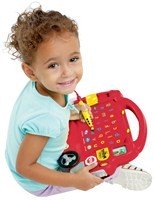Toddler Educational Toys
Toddler educational toys are any toys that encourage your toddler’s development and teach him new things. Many parents readily categorize electronic devices as ‘educational toys’ and buy them for their children, thinking it will help their little people get ahead in some sort of non-focused way. A mini computer that beeps out the alphabet, a tiny ‘myPhone’ which says the numbers as they are pressed.
Those are educational toys, and they can certainly help your child learn the numbers or the alphabet. But the best educational toys are actually simpler, non-automatic toys; toys which help your child learn in a natural, non-forced way.

Like basic wooden blocks. These encourage your toddler’s development of fine motor skills, and give him a thorough education in gravity, balance, and architectural principles. Your toddle learns an immense amount as he sits on the floor, making little towers and pushing them down again.
Other educational toys for toddlers include varieties on blocks—duplo, primo, or megablocks—as well as rubber balls, stacking rings, sorting cubes or simple puzzles. These toys encourage your child in open-ended exploration as well as helping him organize his mind in terms of sets and categories. And, especially if you play with him every now and then, you’ll find these old-fashioned educational toys get old much slower than the newfangled beepers and flashers. Your child can spend untold hours building with his duplo blocks, for instance; and you’ll notice his games getting more interesting and complex day by day.
Old Fashioned Toddler Educational Toys Can Help Your Child
• Improve his fine motor skills
• Improve his coordination
• Learn balance
• Discover gravity
• Learn architectural principles
• Learn categorization
• Discover patterns
• Improve his problem-solving skills
Educational Toys and the Uninterested Toddler
Perhaps you bought toddler educational toys in quantity—blocks, duplo, puzzles, sorters. They are all there, sitting in the toy crates in the playroom, but they’re never taken out. Your toddler would rather watch cartoons instead.
How can you encourage your uninterested child to play with his educational toys you’ve carefully selected for him? To start with, turn off the TV. TV tends to be a ‘least common denominator’ and an automatic default for many children—it requires no exertion, no thought, and is always entertaining. If you care about your child’s development, though, you’ll need to limit screen time to no more than a few hours a day—preferably less.
The other way you can encourage your child to play with his toys is to get down on the floor and play with him. Don’t force your toddler to play; you don’t even need to call him. If you are there in the playroom making towers or castles or smokestacks with the blocks, or fitting shapes into the sorter, it will not be very many minutes before he joins you there.
It’s also important that you make sure his toys are accessible to your toddler when he wants to play with them. Having everything in closed chests or on out-of-reach shelves helps you have an organized, tidy house, but it means you’ve taken away your child’s autonomy: he can only play with those toys if you get them out. It’s okay to save a few toys in inaccessible places for special times, but put the everyday toys in places where your child can and will find them independently. You’ll have to tidy the house more often—but it’s worth it.
Click here to return from Toddler Educational Toys to Toddler Toys
Click here to return from Toddler Educational Toys to Home Page
New! Comments
Have your say about what you just read! Leave me a comment in the box below.